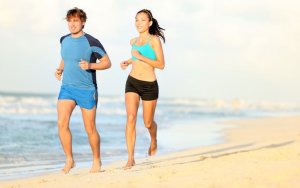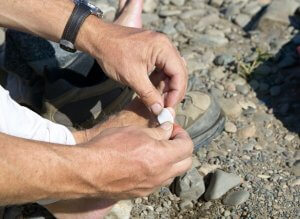Running Barefoot: Advantages and Disadvantages

Although it’s a really old practice, running barefoot is becoming a new trend. ‘Barefoot running’, as it’s been named, means that you have to take off your shoes to run. Unsightly and dangerous? Maybe, but walking barefoot or with minimalist shoes, has its own set of advantages.
For some people it may be a torment, but for others it’s a relaxation technique. However, running barefoot can be a big advantage to help athletes reach their goals. This activity involves short, but fast strides.
Short steps reduce the impact that our feet have against the ground and they help to improve our footsteps. They also improve the posture of the runner. A person wearing running shoes tends to lean backwards, but when they’re barefoot, they stand straight, and in a practical way.
Leads to stronger ligaments
When you run barefoot, you use the middle and front parts of your feet, instead of using your heels as you do when you’re wearing running shoes. If the first thing that comes in contact with the floor are the metatarsal bones, the muscle chains are activated positively. This strengthens the ligaments, prevents injuries and reduces the impact on joints and muscles at the same time.

Contrary to popular belief, wearing cushioned shoes doesn’t help to prevent the impact of the heels against the ground. Therefore, running shoes might even injure the ankles, knees, hips and the entire lumbar region.
The gastrocnemius muscles (calves) and hamstrings align better when you are barefoot. Likewise, we activate underdeveloped sensory motors in the nerve endings of our feet. This way, more intense stimuli or signals reach our brain.
Reduces your energy expenditure
Running barefoot slows down your heart rate, oxygen consumption and therefore your energy expenditure. A common question is whether this improves performance or not? But this depends on the category in which the athlete participates and on their physical condition; some runners have won gold medals in the Olympics while running barefoot.
You can achieve the greatest benefits of running barefoot if you work properly on your tendons and muscles, distributing your weight equally. However, this practice isn’t suitable for everyone. It requires preparation and certain specific conditions.
When is running barefoot counter-productive?
Running barefoot can involve some risks. There must be a transition period from wearing running shoes, to minimalist footwear, to going completely bare foot. It’s essential to get used to ground imperfections and the way they feel, and this is something that won’t happen overnight. It’s advisable to follow a routine for a year or more in order to get used to it.
If you prepare yourself, you’ll prevent the appearance of painful blisters, fractures, wounds and other types of injuries. You definitely need time to become familiar with it, because barefoot running is a whole new technique.
Barefoot running isn’t advisable for those with flat feet, or for those with different leg lengths. Even though it can have a positive impact on the foot’s natural biomechanics, in these cases barefoot running could interfere with the correct functioning of the limbs.

Recommendations
Before running barefoot, it’s advisable to ask a doctor about the physical condition and biomechanics of your own feet. He’ll be able to make the appropriate recommendations for your specific case. It’s also important to avoid defective surfaces at first, since they could cause injuries.
It’s very helpful to start with exercising barefoot on bicycles, running tracks, the beach or places where the terrain is softer on your feet, and where you’ll be safe. You can’t run with fear, or looking down at the ground the whole time. Especially if you’re training for a competition.
Once your feet are used to walking barefoot, blisters, cuts and other common problems will be less frequent. Your skin will not be as vulnerable to those types of injuries anymore.
Fun facts
The perks of barefoot running are not only attractive. It’s already clear that it improves balance, provides strength and flexibility to the feet, stretches the fingers and discards the use of orthotics.
Here are some more interesting facts.
- Achievements. Adebe Bikila won the first gold marathon medal for Africa during the Olympic Games, in 1960; he was running barefoot.
- Beginning. In 2009, Christopher McDougall wrote and published a book called, Born to Run. Perhaps this book was the reason why this trend started? It investigates the people who traveled long distances, by using pieces of tires to cover their feet that were tied with ropes to their ankles. Can this also be a reference to the minimalist culture?
Although it’s a really old practice, running barefoot is becoming a new trend. ‘Barefoot running’, as it’s been named, means that you have to take off your shoes to run. Unsightly and dangerous? Maybe, but walking barefoot or with minimalist shoes, has its own set of advantages.
For some people it may be a torment, but for others it’s a relaxation technique. However, running barefoot can be a big advantage to help athletes reach their goals. This activity involves short, but fast strides.
Short steps reduce the impact that our feet have against the ground and they help to improve our footsteps. They also improve the posture of the runner. A person wearing running shoes tends to lean backwards, but when they’re barefoot, they stand straight, and in a practical way.
Leads to stronger ligaments
When you run barefoot, you use the middle and front parts of your feet, instead of using your heels as you do when you’re wearing running shoes. If the first thing that comes in contact with the floor are the metatarsal bones, the muscle chains are activated positively. This strengthens the ligaments, prevents injuries and reduces the impact on joints and muscles at the same time.

Contrary to popular belief, wearing cushioned shoes doesn’t help to prevent the impact of the heels against the ground. Therefore, running shoes might even injure the ankles, knees, hips and the entire lumbar region.
The gastrocnemius muscles (calves) and hamstrings align better when you are barefoot. Likewise, we activate underdeveloped sensory motors in the nerve endings of our feet. This way, more intense stimuli or signals reach our brain.
Reduces your energy expenditure
Running barefoot slows down your heart rate, oxygen consumption and therefore your energy expenditure. A common question is whether this improves performance or not? But this depends on the category in which the athlete participates and on their physical condition; some runners have won gold medals in the Olympics while running barefoot.
You can achieve the greatest benefits of running barefoot if you work properly on your tendons and muscles, distributing your weight equally. However, this practice isn’t suitable for everyone. It requires preparation and certain specific conditions.
When is running barefoot counter-productive?
Running barefoot can involve some risks. There must be a transition period from wearing running shoes, to minimalist footwear, to going completely bare foot. It’s essential to get used to ground imperfections and the way they feel, and this is something that won’t happen overnight. It’s advisable to follow a routine for a year or more in order to get used to it.
If you prepare yourself, you’ll prevent the appearance of painful blisters, fractures, wounds and other types of injuries. You definitely need time to become familiar with it, because barefoot running is a whole new technique.
Barefoot running isn’t advisable for those with flat feet, or for those with different leg lengths. Even though it can have a positive impact on the foot’s natural biomechanics, in these cases barefoot running could interfere with the correct functioning of the limbs.

Recommendations
Before running barefoot, it’s advisable to ask a doctor about the physical condition and biomechanics of your own feet. He’ll be able to make the appropriate recommendations for your specific case. It’s also important to avoid defective surfaces at first, since they could cause injuries.
It’s very helpful to start with exercising barefoot on bicycles, running tracks, the beach or places where the terrain is softer on your feet, and where you’ll be safe. You can’t run with fear, or looking down at the ground the whole time. Especially if you’re training for a competition.
Once your feet are used to walking barefoot, blisters, cuts and other common problems will be less frequent. Your skin will not be as vulnerable to those types of injuries anymore.
Fun facts
The perks of barefoot running are not only attractive. It’s already clear that it improves balance, provides strength and flexibility to the feet, stretches the fingers and discards the use of orthotics.
Here are some more interesting facts.
- Achievements. Adebe Bikila won the first gold marathon medal for Africa during the Olympic Games, in 1960; he was running barefoot.
- Beginning. In 2009, Christopher McDougall wrote and published a book called, Born to Run. Perhaps this book was the reason why this trend started? It investigates the people who traveled long distances, by using pieces of tires to cover their feet that were tied with ropes to their ankles. Can this also be a reference to the minimalist culture?
This text is provided for informational purposes only and does not replace consultation with a professional. If in doubt, consult your specialist.








